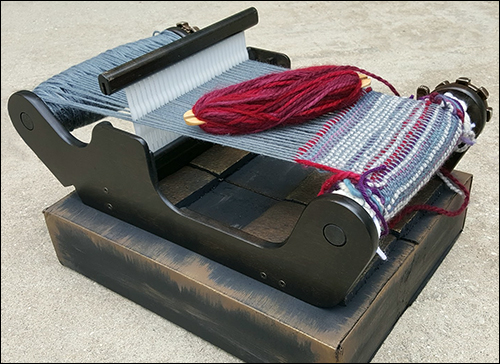Sep 20, 2017University researchers have developed a way to marry old technology, weaving, with something much more modern—video games—in order to help players create stories. The game, known as Loominary, employs RFID technology to link the ancient practice of weaving to an interactive, computer-based game that follows the life of Medusa, a monster of ancient Greek mythology.
Loominary has been exhibited at several venues, and is now available to game developers on an open-source platform. It consists of passive ultrahigh-frequency (UHF) RFID-tagged yarn shuttles, with antennas built into a loom to capture each time a shuttle is used to weave yarn through the tapestry. (The shuttle is an apparatus on which yarn is wrapped; the yarn is then threaded between the warp threads held under tension by the loom).

The tabletop loom has a Linksprite Cottonwood TTL UART Long Range UHF RFID reader built into it with a single antenna, says Josh McCoy, an assistant professor in the computer science and cinema and digital media departments at UC Davis, in the area of games technology. He is also a hardware designer and producer of Loominary.
Each loom is designed to allow users to weave a tapestry that is typically the width of a scarf and can be woven at any length. The loom is cabled to a Raspberry Pi 2 Model B computer running Loominary's software, which interprets read data and links that information to Twine software that displays a story on a screen.
Loominary uses technology to help bring traditional stories to today's audiences, while offering a broad range of experiences, including participating in the storytelling. According to the company, it brings a traditionally male-centered story to underrepresented groups, including women. The software enabling the storytelling was designed to be compatible with Microsoft's Windows IoT software platform.
First, a user opens one of three available stories on the computer. As the tale proceeds, he or she has control of the action. Each story section offers options for the player to select, similar to a Choose Your Own Adventure book. For instance, a player can select options to respond to the arrival of a stranger, the offering of a beverage that could be poisoned, or some other choice that drives the plot forward. The user then makes a selection by picking up a specific color of yarn wrapped around a shuttle (different colors correspond to different plot selections displayed on the screen.)
As the player holds the shuttle over the loom and begins weaving the yarn through the tapestry, the loom reader captures that shuttle's unique ID number. The reader forwards the shuttle ID, linked to the color in the software, to the software, which then displays the next step in the story based on that selection.
As the user continues to play the game, the plot moves forward accordingly, while the tapestry includes colors related to that person's choices. The player uses a large pair of scissors to cut the yarn after each important plot event takes place, so that he or she can begin with another shuttle and color for the next plot selection. The system accommodates a large number of shuttles, but the initial stories feature just six different shuttles, each with its own RFID tag encoded with a unique ID and related yarn color.
"We wanted to build something that was more creative, richer, for the player" than the simple passive reading of a story, McCoy says, or the playing of a video game. With Loominary, users can not only play a game, but walk away with a unique artifact in the form of a tapestry.
Several years ago, McCoy says, he and his fellow researchers were seeking a system that would bring an old-school technology like weaving together with modern digital technology. He began working with colleague Anne Sullivan, who was a postdoctoral student in McCoy's lab at American University and is now an assistant professor of digital media at the University of Central Florida. They needed a system that would provide a fluid, he recalls, and that would engage a link between the physical world and the game software.
"We wanted it to feel almost like a magical experience," McCoy states. The two started development in 2015 with a prototype, then were joined by two graduate students at American University's Game Lab: Brittany Williams, the narrative designer for the project, and Sarah Hendricks, Loominary's lead programmer.
The group had to experiment with RFID. They tested multiple reader and tag combinations using a variety of off-the-shelf UHF RFID tags and readers, in order to accomplish a read range of 6 to 9 inches. To prevent stray reads of shuttles placed near the loom, they lined the weaving equipment with foil. They also spent time ensuring that the reader would capture the tag ID of every shuttle in either direction as it moved through the loom.
Once the reader recognizes a new shuttle, the software updates the storyline on the screen and the reader stops reading tags until it recognizes a new shuttle ID, thus indicating that the user has begun weaving with a new color. The user can also continue with the same color for the next plot selection.
Loominary offers two game modules related to the Greek myths of Medusa and Oedipus, as well as a short, child-friendly story related to a character known as Posy the Unicorn. McCoy says the game is designed to appeal to both older participants who are more artistically inclined (such as weavers) and technology-based players (such as younger individuals who are already experienced with video-gaming but may have no experience with weaving).
The game was in playable form by January of this year, he reports, and was piloted at the Smithsonian American Art Museum (SAAM), as well as at the Electronic Literature Organization conference this past spring. The researchers are now releasing the technology on GitHub as an open-source platform for developers to use in building their own games or systems.
McCoy eventually envisions the system being employed to link players across different geographic regions. Users could, for instance, participate in a storytelling game together, selecting plot choices and weaving identical tapestries. In that way, McCoy says, "Each would have the other people's stories built into their tapestry." Future versions of the game could also incorporate artificial intelligence, or add pop culture to stories—for example, the system could enable players to make a Harry Potter scarf through game play.


